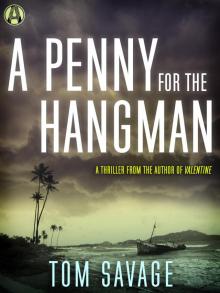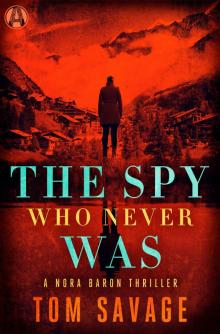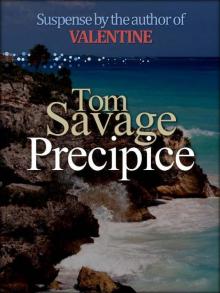- Home
- Tom Savage
Precipice Page 17
Precipice Read online
Page 17
He had risen and followed her out into the garden. Now he stood behind her and spoke softly.
“Yes,” he said. “He killed himself. But I’m not interested in that right now. I’m interested in Karen Lawrence.”
Margaret whirled around to face him. “Why?”
“There aren’t any pictures of her in the clippings,” he explained, “but the papers described her as an ‘attractive redhead.’ ”
“Yes, that’s right,” Margaret said.
“How old was she, Margaret?”
She thought a moment. “I don’t know, about twenty-five. . . .”
“And what happened to her, after the murder and Bert’s suicide?”
Margaret shrugged. “I—I have no idea. I never saw or heard of her again.”
“Did she attend Bert’s funeral?”
“There wasn’t a funeral; they never found him. It was a memorial service. Bert’s parents were dead, and I don’t think he had any other relatives back in Montana or Minnesota or wherever it was. I arranged it, and I took the child. And there was some young man there, one of his mates from the Merchant Marines, who was very upset about Bert’s death. Charlie something. I’ve forgotten his last name. No, she wasn’t there. So?”
He gazed down at the red roses, nodding to himself.
“No,” he repeated softly, “she wasn’t there. She’d already disappeared.” Then he raised his eyes to hers. “Come back to the table, Margaret. I want to show you something.”
The red rose in the glass next to her bed had opened slightly, the soft petals loosening and stretching in the morning sun. She leaned down and breathed in its scent, thinking briefly of her aunt in Glen Cove.
Then she remembered the face of the man who had given her the flower the night before.
Then, as ever, she thought of Adam.
Today was Friday. Next Friday he would leave her, but only for a while. He would deliver his stepdaughter to her mother’s sister, getting her out of the way, and then he would fly to Florida to visit an acquaintance who had recently moved to Palm Beach.
He and the acquaintance, Roger somebody, had won several local races as a two-man team on Roger’s sailboat before a business opportunity had required Roger and his wife to move to the mainland. There was a race in Florida the day after Labor Day, and Adam had contacted Roger two months before and suggested they enter it. The other man had been delighted by the idea, and now Adam had a perfect cover for the plan. He’d stay in a hotel in Palm Beach for a few days, visiting with the man and his family as much as possible before the race. High visibility, he called it.
Nobody would miss him for nine hours on Labor Day, he’d assured her. He’d be back in Palm Beach in time for Roger’s barbecue party that evening, receiving the news of his wife’s tragic death in the presence of many witnesses.
All she had to do was be sure that Kay was alone in the house at two o’clock on Monday afternoon.
She stepped out onto the balcony and gazed around at the bright-blue seascape. The little town across the water to her right seemed to be dozing in the sun. She leaned against the balcony railing, allowing the warmth to enter her skin.
No one could connect her to it, she thought. Any of it. That was the best part, the vital part. Otherwise . . .
She would be away from the house all day, she’d told him. The original idea had been for her to go out on the Kay with Greg on Labor Day. Of course, Greg had disappeared since the plan was first formulated, but there was always Kyle. She could ask Kyle to take her sailing, take him out for dinner and dancing, and return to Cliffhanger late that night to discover the robbery and murder.
She’d met Kyle yesterday on the Kay, and he’d paid no attention to her. Besides, he apparently had a girlfriend, Rita.
But now Bob Taylor had arrived on the scene. The next time she got Adam alone, she’d tell him her new, improved idea.
Things were falling into place.
With a little sigh, she went back into the bedroom. Kay had taken Lisa into town to buy some things for the child’s trip to Connecticut. She almost smiled, remembering how easy it had been to change Kay’s mind on that count.
“Well, if you think it’s best, Diana . . .”
Oh, she did, she assured the woman.
Done.
She checked herself in the mirror. Yes, the hair was holding, and she was actually getting used to the eyes. Then she turned around and glanced over at the closet door. The locked suitcase was in there, behind the clothes. The scrapbook, the dress, the wig, the Kouronos: everything.
The others would be home soon, and there was still one more item on her agenda. She left the room and went downstairs. Nola was about somewhere, so she’d have to be careful in the kitchen. There was a large package of hamburger on the second shelf of the refrigerator. She’d noticed it there this morning.
It was time to do something about the dog.
“What is this?” Margaret asked.
She was again seated at the table on the patio, and the doctor stood beside her, leaning over. He had just placed the scrapbook in front of her, open to the final page of clippings about Bert’s disappearance at sea. Then he turned the page. She was looking down at a new set of headlines, dating from ten years ago. Some sort of murder case in Hawaii. She shrugged: what was the doctor getting at?
“This,” he said, “is something else she obviously found fascinating. Notice the similarity. A rash of robberies in Hawaii. Darlene Bishop Phillips, the Bishop Hotels heiress, is stabbed to death during a robbery attempt at her home on Kauai. Husband away at the time. That’s the fellow, there.”
He pointed. Margaret looked down at a grainy, yellowed photocopy of a front page. A dark-haired man with a beard sat slumped over in a tropical-looking living room, his face buried in his hands, his eyes glazed with shock. Standing behind him, leaning down with her hand on his shoulder, was a tall, slender woman.
“It turns out,” Dr. Stein continued, “that the husband, Drew Phillips, was with this woman at the time of the incident. Her name was Kimberly Brown, an attractive, redheaded widow who lived on Kauai with her baby daughter. She was Drew Phillips’s mistress.”
Margaret looked down at the album with new interest.
“Yes,” she said. “I vaguely remember this. Bishop Hotels—wasn’t the husband eventually murdered as well?”
“Look,” the doctor whispered, pointing down at the album. “She’s saved all the clippings.”
Margaret glanced briefly through the four pages of cutout news items. The last headline, dated three years after the first incident, read “FIRE AT SEA: Yacht Explosion Kills Bishop Murder Husband.” The remains of a man believed to be Andrew Phillips, husband of Darlene Bishop Phillips, had been “partially retrieved.” His mate, a young man named Stephen Ingalls, also of Kauai, was missing. A search of Drew Phillips’s property revealed that his several bank accounts had recently been cleared out.
“The bank accounts they mention were a fair chunk of the Bishop girl’s fortune,” the doctor said. “About three million. What kept people speculating was the fact that Kimberly Brown and her baby disappeared at about the same time.”
Margaret shook her head and leaned back in the chair.
“Very interesting,” she said, “and very sordid. I suppose the Brown woman and the mate killed him and made off with his money. She and the mate could even have killed the wife in the first place. A long-range plan. But what’s the connection?”
He went around the table and sat across from her. Leaning forward, he made sure she was watching him before he went on.
“Your sister was killed, and her husband later died mysteriously. Nearly half of their money disappeared, as did Karen Lawrence, the attractive redhead in her midtwenties who was your brother-in-law’s mistress. Ten years later, in Hawaii, another rich woman is killed in amazingly similar circumstances. Again the husband dies mysteriously, and a lot of money disappears. And again there is an attractive redhead in the story—a wid
ow this time, with a baby, a woman in her midthirties. Kimberly Brown. Please note the presence of boats in both stories as well.
“I keep thinking about the tall figure with the black stocking mask. The child heard a noise coming from her mother’s bedroom in the middle of the night, and she went to investigate. She saw her mother’s body and the figure standing over her. Then the assailant struck her on the head with a heavy object and fled.”
He leaned even closer to her.
“Is it possible,” he asked, “that the figure the child saw that night was a woman?”
When Kay pulled into the driveway, she saw someone kneeling beneath the tamarind, and for a moment she didn’t recognize who it was. Then, as the car drew nearer, she saw that it was Diana, sitting back against the trunk, and that she was not alone. The dog was stretched out on the grass before her, quite still, its head in the young woman’s lap.
As she swung around to park in front of the house, she experienced a brief, inexplicable chill, an undefined, parenthetical moment of disquietude. The figures had not looked up, had not in any way acknowledged the arrival of the car. The shade was too dark, the figures too still, the humidity too close and heavy. . . .
As Kay and Lisa got out of the Land Rover, the young woman raised her hand from the dog’s head and waved to them. Jumbi, as if released from a magic spell, jumped to her feet and bounded out of the shadows and across the grass, black and tan coat flashing in the sun, barking her usual ebullient greeting.
“You seem to have made a new friend,” Kay told the young woman as they walked up to her.
“Yes,” she said, rising. “I decided it was time for Jumbi and me to put our animosity behind us.”
“Come see, Diana,” Lisa said, grabbing her hand and leading her out from under the tree into the sunlight. “The packages are in the car. Let’s take them up to my room. I got a new dress and a pair of jeans and . . .”
They ran off toward the Land Rover ahead of Kay, the dog at their heels. Looking beyond them as she neared the house, Kay saw Nola standing in the front doorway.
“Telephone, Mrs. Prescott,” the housekeeper called. Then, lowering her voice, she added, “It’s the police.”
She saw the dog prancing on the lawn, heard Diana and Lisa giggling together as they unloaded the car, and noted the worried expression on Nola’s face.
She stood in the living room for a long moment, staring down at the receiver resting next to the base of the princess phone.
The police.
At last she took a deep breath and raised the instrument to her ear.
“Hello,” she said. “This is Kay Prescott.”
“Miz Prescott?” The thick, musical calypso accent belonged to the local chief of police, an elderly native man named Potter. What is it? she thought, and why is the chief himself calling me? Oh, God. . . .
“Hello, sir,” she said, trying to keep her voice casual.
“Sahree tuh be bod’rin’ you, Miz Prescott, but we gaht ouhselves a prahblem heah. A missing puhson—”
Missing person, she thought. Oh, God. Adam! He was out sailing again today. . . . “What’s happened, Mr. Potter?”
She clutched the receiver, bracing herself.
“Well, ma’am, we ain’t shuah. Ol’ Digger Joe, you know him? Well, he be out combin’ de beaches dis mahnin’, lookin’ fo stuff—”
Oh, Christ, this man was so old! This could take hours. She bit her lip, knowing it was fruitless to protest, to insult an ancient West Indian gentleman when he was telling a story.
“—an’ he be dahn at dat li’l cove neah de yacht club, pokin’ heah and deah in de sand, you know, like he does, an’ he come upon dese clothes an’ dis puhse lyin’ right deah on de beach—”
Clothes? Purse? What was the man babbling about?
“—an’ he look in de wallet—you know Ol’ Digger Joe, Miz Prescott, always lookin’ fo’ rum money—an’ he fin’ a dribuh’s license wid dis name on it”—he paused a moment, obviously reading from some report on his desk—“dis name, Sandra Franklin. An’ we done brung it heah to de Fort. Now, I see dis name an’ I says to myself, Sandra Franklin. Wasn’t dat de young Stateside geahl up by Cliffhanguh?”
A guilty sense of relief flooded through her. It wasn’t Adam. It was something else entirely. Sandra.
“Mr. Potter,” she said as firmly as possible, “has something happened to Sandra?”
“Ah!” the chief exclaimed. “I wuz right. She does wuhk fo’ you.”
“She did work for me, Mr. Potter. She left my employ about three weeks ago, and I haven’t heard from her since.”
There was a pause on the line as the old chief processed that information. “Well, ma’am, Ol’ Digger Joe, he find huh clothes and puhse. An’ huh cah is pahked neah de cove, but ain’ nobody know wheah de geahl be. We tink maybe she done drahned.”
Drowned. Sandra. . . .
“That’s terrible,” Kay said. “Is there anything I can do?” My God, she was thinking. First Jack and Nancy Breen, now this. What next? These things always come in threes. She tried to concentrate on Mr. Potter, who was speaking again.
“Do you know how we c’n get in touch wid huh fambly?”
She stared out at the sundeck, searching her mind.
“No, sir, I don’t,” she said at last. “Sandra never mentioned a family.”
“Hmmm. Miz Prescott, we don’ know nuttin’ ’bout dis geahl, only what we find in huh puhse. Could you come dahn by de Fort dis aftuhnoon? Maybe you can tell us sometin’ dat can help us.”
She sighed and glanced at her watch. Poor Sandra, she thought. Well, I can show Potter the reference I got from Joan Hirsch, her previous employer. Maybe Joan knows something about a family.
“I’ll come now,” she said.
Margaret raised an imperious hand.
“Enough,” she said. “So according to your theory, we’re looking for a tall red-headed woman, about forty-five years old. Someone the girl is—” She broke off, unable to think of a word.
“Tracking,” the doctor suggested. “The woman may have a child between the ages of”—he calculated—“eleven and fourteen. And it’s entirely possible, given Karen and Kimberly, that her first name begins with the letter K.” He leaned forward in his seat and spoke in a low, clear voice. “Your niece had always been very troubled. Suddenly, ten years ago, about the time of the murder of the hotel heiress in Hawaii, she became calm, serene, as if she’d just solved some major problem. This incident made national headlines, and this photo”—he pointed down at the picture of Drew Phillips and the woman named Kimberly—“was in every paper in the country. She was in boarding school at the time, but she could have seen it and recognized her mother’s assailant. For the next three years, she didn’t know what she was going to do with her knowledge, but she at least knew where the woman was. Then, seven years ago—about the time the husband’s yacht burned and Kimberly Brown disappeared—your niece did something very interesting.”
Margaret felt the chill moving slowly down her spine. She swallowed, trying to soothe her suddenly parched throat.
“She quit her job,” she whispered, “and went to—”
“—Hawaii,” the doctor finished. “Looking for clues, perhaps, to the woman’s whereabouts. When she realized that Kimberly Brown was gone without a trace, she may have lapsed into a state of despair.”
“She met those flower children, or whatever they were,” Margaret continued, “and went with them to a commune in San Francisco. . . .”
The doctor nodded. “And the rest, as they say, is history. Abortion, suicide attempt—and all in a time when she didn’t know where her mother’s killer was, when she again believed that the person who had destroyed her life would go forever unpunished. Then, three years ago, she began her second period of unexplained serenity, and a few months ago she took off for the Caribbean. Now she’s back there.”
Margaret stared at him. “I don’t understand. What could possibly make her—”
Dr. Stein reached down to the scrapbook and riffed through the heavy vellum pages to the final entry at the back. It was a single clipping from the Virgin Islands Daily News, dated June 7 three years before, centered on the last page of the album. Some sort of society-page notice, announcing the marriage of local widow Kay Belden to a man named Adam Prescott, an international sportsman new to the island. What was unusual about the clipping was not the article itself but the blank space next to it. The newspaper border was still cemented to the page, but a two-inch square, probably a photograph, had been carefully cut away.
Margaret gazed down at the tiny newsprint and the gaping hole beside it. Then she closed her eyes and shuddered. Kay Prescott. Her daughter had just celebrated her thirteenth birthday, according to—
“We can clear this up fairly easily,” she said. And with that she stood up and went into the house.
Dr. Stein rose and followed her into the living room. She walked over to the piano, picked up one of the framed pictures on top of it, and handed it to him. It was a photograph of a young red-headed woman, standing with the child in front of the house in Islip.
“That’s Karen Lawrence,” she said.
She proceeded across the room and into her office. By the time he joined her there, she was already speaking into the phone.
“Robin, I’m so glad I caught you. Listen, those photos you mentioned yesterday, the ones you took on the boat . . . yes, well, is there a—what do you call it?—a fax service on the island?”
Kay walked slowly out of the police station in the old stone fortress on the Waterfront at the edge of town and made her way down the hill to the lot where she’d parked the car. She glanced at her watch. Go home, Kay, she thought. Time to go home.
She wandered into the parking lot, playing back in her mind the scene in Chief Potter’s office. He’d been extremely kind, even solicitous. Joan Hirsch had joined them, but she was unable to shed any light: all she’d had from Sandra was the recommendation of an employment agency in the States. A long-distance call revealed that the agency was no longer in business. Dead end.

 The Devil and the Deep Blue Spy
The Devil and the Deep Blue Spy Scavenger
Scavenger A Penny for the Hangman
A Penny for the Hangman The Woman Who Knew Too Much
The Woman Who Knew Too Much Mrs. John Doe
Mrs. John Doe The Spy Who Never Was
The Spy Who Never Was Precipice
Precipice